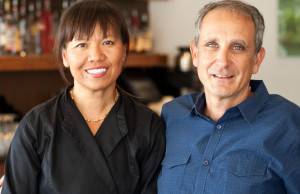Restaurant Owners and Concept Developers – Bill and Zahidah Hyman
Bill and Zahidah have developed a successful, upscale Asian restaurant concept. They now have two locations and are looking to expand into another city. They achieved success in this highly competitive industry through hard work and attention to detail. In this article, they share with you the things you should consider if you want to develop your own restaurant concept as well as the basics of operating the business. This article should be read by those of you interested in owning or working in a restaurant and especially anyone wanting to test their own restaurant concept. It is also a good case study for entrepreneurs who want to start a business as many of the principals they used to develop their restaurant concept also apply to other kinds of businesses start-ups.
Summary
 My family moved to Tulsa when I was in high school when my father took a job in the maintenance department of a major airline. When I transferred schools I found myself ahead of the other students in my classes and quickly got bored. So I worked a lot during high school even washing dishes in a restaurant for $3 per hour. When I graduated, I didn’t want to go to college even though I had good grades. Instead, I began working as a waiter. At the time I thought that the money was good and I liked the flexible hours. I decided to travel and went around the country working as a waiter to pay my living expenses. When I was twenty-five, I saw my friends who had gone to college starting careers and decided to move back and attend college myself. I was able to pay for most of my college by working as a waiter on the weekends in an upscale restaurant where I earned $400 to $500 a week. I wanted to finish college as quickly as I could so I took eighteen hours per semester and graduated after three years with a degree in marketing. It was also during my time in college that I met and married Zahidah.
My family moved to Tulsa when I was in high school when my father took a job in the maintenance department of a major airline. When I transferred schools I found myself ahead of the other students in my classes and quickly got bored. So I worked a lot during high school even washing dishes in a restaurant for $3 per hour. When I graduated, I didn’t want to go to college even though I had good grades. Instead, I began working as a waiter. At the time I thought that the money was good and I liked the flexible hours. I decided to travel and went around the country working as a waiter to pay my living expenses. When I was twenty-five, I saw my friends who had gone to college starting careers and decided to move back and attend college myself. I was able to pay for most of my college by working as a waiter on the weekends in an upscale restaurant where I earned $400 to $500 a week. I wanted to finish college as quickly as I could so I took eighteen hours per semester and graduated after three years with a degree in marketing. It was also during my time in college that I met and married Zahidah.
When I graduated, I took a job as a wine sales rep. That job involved a lot of entertaining, travel and unpredictable hours. But entertaining people at lunches, dinners and wine tastings made me gain a lot of weight, something I didn’t like, and I began looking for another job. The dream sales job at that time was being a pharmacy rep. It took me a year of trying, but I was able to get a job with a major pharmaceutical company and left the wine distributor after three years. But I found that I didn’t like that job either. One reasons was that doctors are always busy so you never got to spend much time with them. This meant there was never the opportunity to build personal relationships, something that was important to me. During this time, Zahidah was working in a high-end retail store and found that she enjoyed dealing with the public. About two years into the pharmaceutical job, I inherited a little money after my parents died and we decided to try and buy a business. Because neither of us had business experience, we first looked at buying an established business. But we didn’t find anything we liked after a long search. Instead, we decided to buy a franchise for a new restaurant concept that was much like Panera Bread. The franchise provided everything we needed to get started including designing the build out and training manuals. The first location was in a local mall. It did well enough that we were able to get a SBA loan to purchase a second location. After three years, we both thought that we had learned enough about the restaurant business to try something on our own. We had paid off the SBA loan by that time and when we sold the two businesses we reinvested the proceeds in our own restaurant concept.
My wife is Cambodian and we both liked Asian food. While there were a number of Asian restaurants in town, none of them had good décor and their wine selection was pink, red or white. We felt there was a market for an upscale Asian restaurant with a better menu, modern decor and a good wine list. My wife had a number of family recipes that we used to develop our menu. We also found a location to lease in a building in an area of town that was being redeveloped and where higher income people were patronizing the new stores and restaurants. The developer of the location we chose turned out to be a successful retail storeowner Zahidah knew who helped us in many ways. The owner gave us a $50,000 allowance for the build out and also put us in touch with an architect who helped us design the restaurant and a decorator. He also helped us choose a name. He said that often a restaurant is named after the chef. My wife’s maiden name was Keo, which is what we used as the name for the restaurant. We opened four months after we signed the lease. The business did well and we opened a second location three years later and are now looking at a third location in another city.
Before You Start Your Own Restaurant Business
It is important that you have gained some experience in running a restaurant before you start even if it is only running a sandwich shop or as a restaurant manager. Although there is a much greater investment in a full service, upscale restaurant, a lot of the principles you learn running a small restaurant or working as a manager of someone else’s restaurant will apply to your own operation. One of the upscale restaurants where I started out as a waiter let me move up and run the bar and later become one of the managers. That kind of experience teaches you how to satisfy customers, hire and train your waiters and bartenders and schedule your staff. These are the things your customers see and are what we call “the front of the house”. The “back of the house” is the kitchen.
It is important that you have someone who knows how to organize your kitchen not just cook. Zahidah was a good cook. But she had never cooked with a commercial wok, which can be intimidating because of the high heat. There is also a lot of prep work that is involved each day as well as finding reliable food suppliers who can provide you high quality produce and meat at reasonable prices. You must have some experience dealing with these suppliers who are critical to the “back of the house” functioning well. For example, we get fresh produce in every day and meat every third day. We don’t freeze any of our food and do food preparation every day so that everything is always fresh for our customers. You also have to know how much food to order. We have lists of how much we like to keep in stock for each item on the menu and adjust our ordering based on demand. It is a balancing act because it is expensive to throw out food that is not used. How to manage your food purchases takes some experience. We hired an experienced chef to organize the back of our house although Zahidah still makes sure the food is prepared correctly and provides general supervision for the kitchen operations.
Developing Your Restaurant Concept
You first need to look at the overall market for your concept. We thought the local market would support an upscale Asian restaurant in part because as the population in our city and in the US in general becomes more diverse, there is a demand from the public for a wider variety of food. People are also becoming more health conscious. Asian food has gained popularity as people look for tasty, lower calorie food choices. We also thought that within the Asian food market there was a local niche for an upscale, Asian restaurant with a unique menu. While there was a Pei Wei in town, our concept is lighter and we think healthier in terms of the dishes we have chosen for the menu and the way the menu items are prepared. For example, most Asian restaurants serve dishes with duck, which has a lot of fat. We trim and drain all the fat off our duck, which surprised our cooks who had worked in other Asian restaurants. The duck is combined with vegetables in stir-fries and crepes. We also drain fats off our soups, use natural spices for flavors, limit the use of salt and never use flavor enhancers like MSG. We developed at least three different recipes for each item on the menu and then had tastings so we could get the feedback from other people before we finalized our menu.
When you have developed your initial menu, you also have to consider restaurant décor and design. We chose a modern, clean minimalist look that we felt would be popular with the kind of customers we were trying to attract. We also hired a decorator to help us choose the furniture, paint color and wall decorations. The design also had to be efficient in both the front of the house and the back of the house. I can tell you that what often looks good on paper does not always give you the flow you need for your wait staff to move around tables or for efficiency in the kitchen. For example, the pickup window for our wait staff did not work well once we saw it built out as well as some of the table and booth locations. You will need to be there during the build out to make decisions about inevitable changes to the architect’s drawings that are likely going to be needed.
This design process involves a lot of other choices. For example, you need to decide on the type of silverware, the kind of tables, chairs and other furniture and their wood stains as well as glass designs for beverages. You also need to design the written menu where you will need to consider things like what kind of material it is going to be printed on and how it is to be presented. Ours is presented in a leather folder with the menu printed on a special card stock. Then when you look at the kitchen, you have equipment choices for stoves, sinks, refrigeration and cooking utensils.
It is also important if you serve wine and liquor to choose a good wine list and also develop some cocktail recipes that work with your theme.
Opening and Running Your Restaurant
In order to open any restaurant you first have to pass a number of city inspections. This can be frustrating. We had one inspector who said the toilets were too close to the wall so we moved them. He came back and said they were now too far away from the wall. The fire marshal had some concerns about some of our decorations that we had to change. You also have to get your liquor license, which in some states can be daunting. We think it is hard for an upscale restaurant to successfully compete without a full service bar.
A few weeks before you open you have to hire and train a staff. Besides showing them how you want the food served and how you want them to interact with your customers, you also have to give them a policy manual that you have developed. For example, there should not be any misunderstanding about how tips are to be paid. Most of our bills are paid with credit cards. So most of the cash we have on hand is to pay the wait staff each night. They cannot be expected to wait to be paid until your receive reimbursement from the credit card companies. There is also a policy that some of those tips are shared with the bartenders. We also have policies about how the staff is scheduled so that prime times and slower periods are shared.
You have to decide on who is going to supply your food and the delivery times. As I mentioned earlier, we get our produce every day and our meat every three days. Some of this is delivered very early in the morning when we are not there. Other products are delivered later but still early enough for us to do our food prep for the day. Everything we serve is made fresh that day and our food prep has to be done before we open the doors at eleven.
The hours you must put in when you first open are daunting, usually sixty or more. Plus you have to understand that you work Friday and Saturday nights, which limits time you can spend with many of your friends and family. But as you train your staff and gain confidence in their abilities, you can begin to step back a little. But you are still going to be working longer hours than most people with a regular job and on weekends. This is something that almost all business owners face, the demands on their time. I now take off after the afternoon rush so I can pick my kids up from school and spend time with them. I also trade off with Zahidah on shifts and work at one location or the other every other day. We are also developing people to become managers who can take over for us when we both want some time away from the restaurant.
Zahidah and I both feel that you must also be constantly improving your menu and looking for ways to get more customers. This is a little different approach than some restaurant owners who pride themselves on keeping the menu the same as it was years ago at the time the restaurant opened. Although a few are successful, we have seen many close because their clientele aged and they had not changed their menu so that they could attract a broader clientele. We are constantly looking at broadening our customer base by testing new recipes as specials and putting the ones that do well on the menu to replace those are not selling as well. We also look for ways to attract new customers such as opportunities to do catering.
It is also helpful if you as a restaurant owner are a little bit of a handyman and can do things like basic plumbing. First, it is difficult in our town to get a plumber when you need one. You cannot close the restaurant because you are waiting for a plumber to unclog a floor drain or do a simple repair on a toilet where there is water leaking on the floor. It is also expensive to call these kinds of skilled tradesmen for what are often simple repairs that occur regularly in a restaurant.
What We Like and Don’t Like About Owning a Restaurant
- To us there is great personal satisfaction in seeing something you have developed from scratch succeed. There is also a sense of independence running your own business where the successes and failures are your own responsibility.
- Both Zahidah and I like people. Personal relationships are important to us. We enjoy meeting with and talking to our customers. Many of them become personal friends. We also like the opportunity to develop our restaurant staff and see people who we have trained grow and take on more responsibilities.
- We are happy to be doing something we enjoy. Too many people are stuck doing something they don’t like
- A successful restaurant can be financially rewarding especially if you can add other successful locations. We are planning on expanding once again this time in another city and are going through the same process of studying that city’s demographics and looking for the right location.
- My wife and I both like and appreciate good food. When you run this kind of business you always have access to good food.
- The main thing that is difficult about this business is the time you must devote to it to be successful. You have to be there to meet and greet your customers as well as manage the operations. When you have young children, you spend more time away from them than you would like.
How to Prepare Yourself
If you think you might want to start a restaurant yourself, it is important that you first get experience running one. It is a business. Being a great chef does not guarantee that you will have a successful restaurant. There are several good chefs in our town who left jobs when they gained a lot of notoriety to start their own restaurant and went out of business. So my view is that it is more important to gain actually management experience than it is to take culinary classes. I started as a waiter and worked my way up to a manager. My wife and I also ran a franchise restaurant for three years before we tried to develop a restaurant on our own. Do something like this where you run even a small food business to get your feet wet before you make the time and money commitment to start a full service restaurant.
Restaurants are somewhat expensive to start, especially upscale restaurants. Including the build-out money we received from our landlord, our first location cost over three hundred thousand dollars to open. That means that for most people you are going to have a big part of your personal net worth invested in the business. Make sure you have done your homework about the concept and tested your management skills in a smaller setting before you take that step.
US Bureau of Labor Statistics for Salaried Restaurant Occupations
Food Service Managers
The lowest 10% earned less than $30,820 and the top 10% more than $81, 820 with the median salary being $47,9780.
Job opportunities should be best for managers with several years of work experience in a restaurant or food service establishment.
Chefs and Head Cooks
The median annual wage for chefs and head cooks was $42,480 in May 2012. The median wage is the wage at which half the workers in an occupation earned more than that amount, and half earned less. The lowest 10 percent earned less than $24,530, and the top 10 percent earned more than $74,120.
About 13 percent of chefs and head cooks were self-employed in 2012 and ran their own restaurant or catering business.
The level of pay for chefs and head cooks varies greatly by region and employer. Pay is usually highest in upscale restaurants and hotels, where many executive chefs work, as well as in major metropolitan and resort areas.
Most chefs and head cooks work full time and often work early mornings, late evenings, weekends, and holidays. Many executive chefs and chefs who run their own business work 12-hour days because they oversee the delivery of food products early in the day and use the afternoon to prepare special menu items.
Restaurant Profitability
Profitability varies greatly by region and by the type of restaurant with up scale restaurants having the best margins. The most recent surveys YPNG has found show that the average profit for all restaurants in the US is around 20% of sales.
The failure rate for restaurant start ups after five years is about 60% according to recent articles in Bloomberg and BusinessWeek, which is about the same as for all small business start-ups in the US. The failure rate for all business startups drops sharply after the fifth year and begins to fall in line with general failure rates for all businesses of around 5%.






